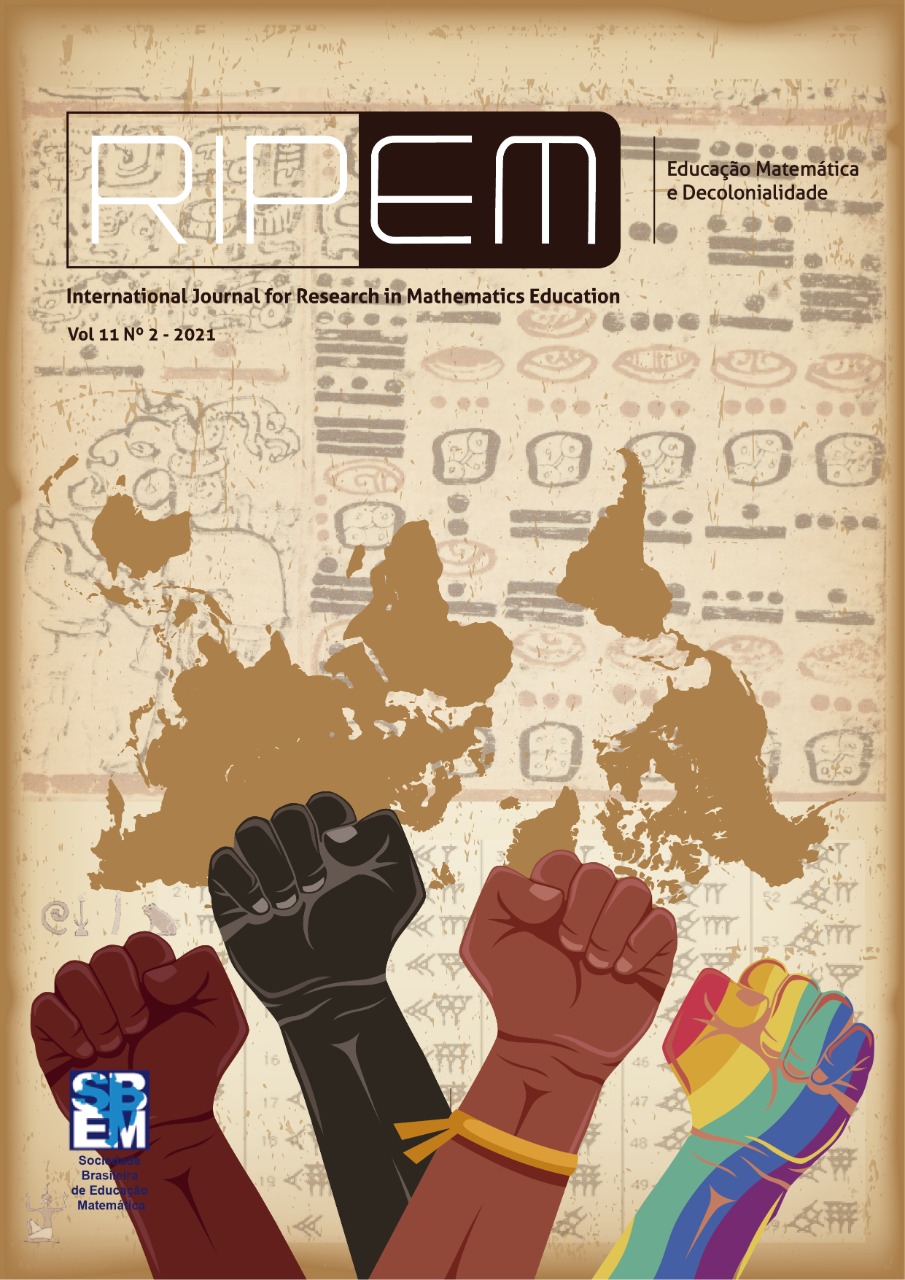Tarumbeta and its mathematical potentialities
DOI:
https://doi.org/10.37001/ripem.v11i2.2448Keywords:
Game, Tarumbeta, Ethnomathematics, Ethnomodeling, Cultural ArtifactAbstract
The article aims to demonstrate the ethnomathematics potentialities of the Tarumbeta game whose rules guide ways of thinking and acting based on mathematical ethno models of African origin. The study dialogues with the perspective of Ethnomathematics and ethnomodeling as possibilities of articulation between emic and ethical knowledge in game situations where the values of the African worldview are present, such as orality, ancestry, cooperation, among others. Mental counts and calculations are also mentioned, which, within the limits of the game rule, refers to African thought. The game is approached as a provider of circumstances for the production of knowledge through problem situations whose solution requires decision making and active participation of players. In this sense, the question that drives the study is to know: What mathematical knowledge is Tarumbeta capable of mobilizing in the outsider observer? To approach an answer, the aim is to capture the emic ethnomodels present in the rules of the game whose interpretation mobilizes ethical ethnomodels of the outsider observer, generating dialogical knowledge that articulates different logics. It is argued that the Tarumbeta game has pedagogical potentials that dialog with the objects of knowledge provided for in the curriculum of the Brazilian school, such as counting, triangular numbers, arithmetic progression, Tartaglia's triangle, among others.
Downloads
References
Bassanezi, R. C. (2015). Modelagem matemática: teoria e prática. São Paulo:
Bassanezi, R.C. (2002). Ensino-aprendizagem com modelagem matemática: uma nova estratégia. 3 ed. São Paulo: Editora Contexto.
Berger, P. L., &Luckmann, T. (2007). A construção social da realidade. Editora Vozes.
Bernardino-Costa, J., &Grosfoguel, R. (2016). Decolonialidade e perspectiva negra. Sociedade e Estado, 31(1), 15-24.
Campos, M. D. (2002). Etnociência ou etnografia de saberes, técnicas e práticas? In Amorozo, M. C. D. M., Ming, L. C.& Silva, S. P. (Orgs.). Métodos de coleta e análise de dados em etnobiologia, etnoecologia e disciplinas correlatas. Rio Claro: UNESP/CNPq, p. 47-92.
Carvalho, J. M., & Silva, S. K. (2009). O “uso†dos artefatos culturais como movimentos táticos e estratégicos, em espaços lisos e estriados, nos currÃculos praticados no cotidiano escolar. Revista Teias, 10(20), 14.
Certeau, M. (2001). A invenção do cotidiano 1: artes de fazer. Petrópolis: Vozes.
Chavellard, Y. (2000). La transposición didáctica: del saber sábio al saber enseñado. Buenos Aires: Aique.
Cunha, D. A. D. (2016). Brincadeiras africanas para a educação cultural. Castanhal, PA: Edição do autor.
D’Ambrosio, U. (1990). Etnomatemática: arte ou técnica de explicar e conhecer. São Paulo: Ãtica.
D’Ambrosio, U. (1993). Etnomatemática: um programa. A Educação Matemática em Revista, 1(1), 5-11, 19.
D’Ambrosio, U. (2000). Etnomatemática e modelagem. InI Congresso Brasileiro de Etnomatemática CBEm,1, 2000, São Paulo. Anais.São Paulo: EDUSP.
D’Ambrosio, U. (2005). Sociedade, cultura, matemática e seu ensino. Educação e Pesquisa, São Paulo, 31(1), 99-120.
Eglash, R., &Odumosu, T. B. (2005). Fractals, complexity, and connectivity in Africa. What mathematics from Africa, 101-109.
Ferraço, C. E., Soares, M.C.S., & Alves, N. (2018). Michel de Certeau e as pesquisas nos/dos/com os cotidianos em educação. Rio de Janeiro: EdUERJ.
Gerdes, P. (2007). Etnomatemática: Reflexões sobre matemática e diversidade cultural. Edições Húmus,LDA.
Gerdes, P. (2008). A Numeração em Moçambique: contribuição para uma reflexão sobre cultura, lÃngua e educação matemática. Maputo, Moçambique: Centro de Pesquisa para Matemática, Cultura e Educação.
Gerdes, P. (2008). A Numeração em Moçambique: contribuição para uma reflexão sobre cultura, lÃngua e educação matemática. Centro de Pesquisa para Matemática, Cultura e Educação.
Grosfoguel, R. (2007). Dilemas dos estudos étnicos norte-americanos: multiculturalismo identitário, colonização disciplinar e epistemologias descoloniais. Ciência e cultura, 59(2), 32-35.
Lei 10.639/2003, de 9 de janeiro de 2003. Altera a Lei nº 9. 394, de 20 de dezembro de 1996. Diário Oficial da União, Poder Executivo, BrasÃlia.
Lett, J. (1996). Emic-eticdistinctions. In Levinson, D. eEmber, M. (Eds.). Encyclopediaof cultural anthropology. New York, NY: Henry Holt and Company.
Lima, E. L., Carvalho, P. P., Wargner, E., & Morgado, A. C. (2016). A Matemática de Ensino Médio. 7. ed. Rio de Janeiro: SBM.
Maldonado-Torres, N. (2016). Transdisciplinaridade e decolonialidade. Sociedade e estado, 31(1), 75-97.
Marconi, M. A., & Lakatos, E. M. (2014). Sociologia Geral. 7 ed. São Paulo: Atlas.
Raum, O. F. (1996). Chaga Childhood: a descripition of indigenous education in an East African Tribe. Humburg: LIT.
Rosa, M. &Orey, D. C. (2017). Etnomodelagem: investigando saberes êmicos e éticos em uma abordagem dialógica. Journal of Mathematics and Culture, 11, 1-21.
Rosa, M., &Orey, D. (2009). Symmetricalfreedom quilts: theethnomathematicsofwaysof communication, liberation, and art. Revista Latinoamericana de Etnomatemática, 2(2). 52-75.
Rosa, M., &Orey, D. C. (2003). Vinho e Queijo: Etnomatemática e Modelagem. Bolema, Rio Claro – SP, v. 16, n. 20, set.
Rosa, M., &Orey, D. C. (2012). O campo de pesquisa em etnomodelagem: as abordagens êmica, ética e dialética. Educação e Pesquisa, 38(4), 865-879.
Rosa, M., &Orey, D. C. (2013). As abordagens êmica, ética e dialética na pesquisa em etnomodelagem. Actas del VII CIBEM, 2301(0797), 3475.
Rosa, M., & Orey, D. C. (2014). Etnomodelagem: a abordagem dialógica na investigação de saberes e técnicas êmicas e éticas.Revista Contexto & Educação, 29(94),132-152.
Rosa, M., & Orey, D. C. (2018). Etnomatemática: investigações em etnomodelagem. Revista de Investigação e Divulgação em Educação Matemática.
Scherer, P. (2013). Natural differentiation in the teaching of mathematics to children starting school. South African Journal of Childhood Education, 3(1), 100-116.
Silva, S. K. (2015). Cartografia das artes de fazer e de nutrir. Instrumento: R. Est. Pesq. Educ., Juiz de Fora, 17(1), 11-20.
Zaslavsky, C. (1991). Ãfrica conta: Número e Padrão na Cultura Africana. Boston: Prindle, Weber & Schmidt
Published
How to Cite
Issue
Section

This work is licensed under a Creative Commons Attribution-NonCommercial-NoDerivatives 4.0 International License.








